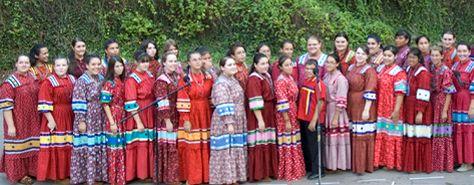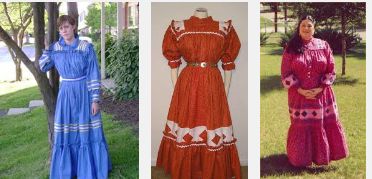Last Updated: 9 months The Cherokee Nation is the only tribe to my knowledge to legislate a specific style of clothing as the official tribal dress. The Cherokees of North Carolina have a completely different style of dress.

A Cherokee Tear Dress must have these basic elements of construction and design:
- All pieces of the dress must made of squares and rectangles; The bodice must be gathered onto a shoulder yoke and open up the front;
- There must be square gussets under the arms where the sleeves attach to the bodice;
- There must be a stand up ruffle where the lower bodice and sleeve are attached to the yoke and where the skirt flounce is attached to the upper skirt panels;
- It must have decorative fabric bands at certain places on the dress, which are over each shoulder of the yoke, around each sleeve, and around the upper shirt just above the flounce.
A woman may choose a number of variations that reflect her own sense of style:
Any kind of fabric is acceptable as long as it can be gathered softly (cotton calico, prints and solid, any type of fabric weave including broadcloth, crepe or chiffon); A choice of skirt length, either ankle or floor length for ceremonial events, or below the knee length for social, formal and daytime wear. Stomp dancers usually choose a shorter length. A choice of sleeve lengths — elbow, three-quarter, or wrist length is acceptable.
The decorative bands may be plain and solid, have cut-out and/or appliqued motifs of a combination of square and triangle shapes, or embellished with beaded or embroidered motifs of trailing vine-like designs that are consistent with the traditional Southeastern Woodland tribes. The neck opening may be finished with a stand-up band collar, a round neck with no collar or finished with a ruffle, or a plain faced square neck opening.
Every contestant who enters the annual “Miss Cherokee” contest must wear a Tear Dress of any variation of the above style choices, as long as it is cut accurately from squares and rectangles and has a square arm gusset under the arm. The Tear Dress has been a contest requirement since 1969. Miss Suzy Coon was the first girl to compete and be crowned as Miss Cherokee in a Cherokee Tear Dress.The first official tear dress was made for and worn by Virginia Stroud during her reign in the titled position as “Miss Indian America” 1969.
The word “tear” is pronounced as in “rip and tear”, not tear as in the act of crying or in Trail of Tears. No one can remember who named it the Tear Dress. The name in Cherokee is onomatopoeia; it describes how the pieces of the dress are cut during construction. The original dress was constructed of simple shapes of squares and rectangles and each piece was torn across the grain of the fabric and not cut with scissors.
The Cherokee Tear dress is a basic shirt-waist style. The bodice top (the old fashion term is waist) is attached to the skirt by means of an inset waistband and closes up the front with buttons, much like a man’s shirt.
To provide ease, a shape and form, larger pieces are gathered and sewn onto smaller pieces of the garment.
Historically, this style of shirt-waist dress was worn by working class women — trades people, farmers, crafters, etc., who did not have the luxury of having a personal attendant to help them get dressed each day like the privileged class who dressed in stylish, form fitting garments that were fastened up the back with rows of hooks and eyes.
This was the type dress that was made at home, either by a member of the family, or by the neighborhood seamstress.The Cherokee Tear Dress is practical for two reasons:The fullness of the gathered bodice and skirt gave the wearer freedom of movement to do the labor of daily work chores, and the one piece construction allowed women to bend and stretch with out fretting with the problem of keeping a waist tucked in or hooked to a skirt.
Making a Cherokee Tear Dress requires a medium-to-advanced knowledge of garment construction and sewing skills. A well fitting dress requires taking accurate measurements, a fair understanding of the sequence of steps needed to cut, sew and finish the dress, and a lot of patience. There are a few commercially printed tear dress patterns now available on the market, but none give complete instructions or are self-explanatory to the novice dressmaker.
Measurements:
Every tear dress is a one-of-a-kind original creation and is usually made to fit the individual.
The primary measurements required are:
- Length of the bodice from shoulder to waist (front and back); Opening of the front from neck to waist;
- Length of skirt from waist to finished hem;
- Length of sleeve from tip of the shoulder to finished sleeve band;
- Width of shoulder yolk across the back from tip of the arm to tip of the arm;
- Waist and finished waistband;
- Sleeve band at the finished length of the sleeve. Bust and Hip measurements are not too important except if the woman is extremely busty or has large hips in proportion to her waist. You then have to allow extra fullness to the width of the pattern pieces to in the front lower bodice and the skirt.
Cutting:
Every piece of the original Tear Dress was a torn square or a rectangle. At the time the dress was made, cotton goods on the bolt were generally only 18 or 24 inches wide, perfect widths for the pieces of a Tear Dress. 100 percent cotton materials are easy to tear across the grain from salvage to salvage.
Modern day cotton/polyester fabrics must be cut, otherwise they leave a ragged, puckered edge. Twenty-four inch fabric, which was the standard for all cotton prints and calicos up until the early 1960’s, was the ideal width for making a tear dress.
For an average person, sleeves could be made twenty-four inches wide; a skirt could be made of three panels (72 inches) giving a seam opening down the front of the skirt; the lower back bodice piece and the two front bodice pieces (torn length ways in half) could each be one width of fabric; the 18 inch square yoke could be cut from one width — the remaining six inches piece would be used for sleeve bands, neck bands or front/placket opening facings.
Modern day fabrics are now between 42 to 45 inches wide and require making a cutting guide to plan how to cut the widths and the length of each piece to approximate the proportions of the original dress.
About the Author: Mr. Wendell Cochran is an enrolled member of the Cherokee Nation of Oklahoma. In 1989, the Tribe and the Cherokee National Historical Society awarded Mr. Cochran the title of Master Craftsman and National Living Treasurer in the Area of Traditional Cherokee Clothing. Mr. Cochran can be contacted by e-mail: gwywendell@tah-usa.net

